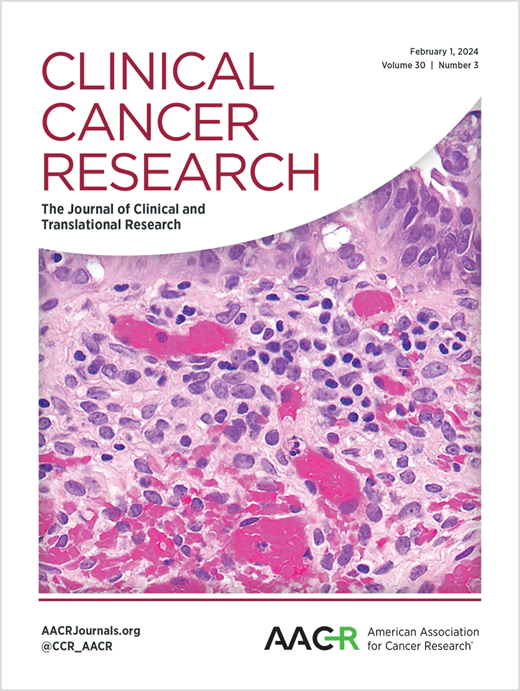口腔癌的神经类型和神经分类。
IF 10
1区 医学
Q1 ONCOLOGY
引用次数: 0
摘要
目的:虽然已知口腔鳞状细胞癌(OSCC)的神经侵袭与生存不良之间存在关联,但支配神经的类型尚未明确确定;这混淆了机械和转化研究。因此,我们研究了人类OSCC的神经支配,并在小鼠中进一步探讨了这些发现。实验设计:通过免疫组织化学鉴定71例患者的感觉神经、交感神经和副交感神经,并将其与神经表型联系起来。此外,我们利用神经元追踪转录组分析和转基因小鼠研究了OSCC的感觉神经支配。结果在OSCC中,大多数神经为感觉神经或感觉神经与其他类型神经混合。与边缘相比,肿瘤块内纯感觉神经和混合感觉和交感神经的存在显著增加,而混合交感和副交感神经的存在则减少。纯感觉和混合感觉和交感PNI+(神经周围浸润)神经的比例显著高于混合交感和副交感神经的比例显著低于PNI(-)神经。小鼠肿瘤神经支配三叉神经感觉神经元的分类显示钙+肽能伤害感受器的增加和低阈值机械感受器的减少。利用转基因报告小鼠验证神经支配,我们发现小鼠舌SCC受rt+和Calca+伤害感受器的支配。结论本研究首次对OSCC的神经类型进行了综合表征,并对支配三叉神经的感觉神经元进行了分类。我们的研究结果强调了感觉神经支配在OSCC中的重要性,并且与治疗策略的机制和转化研究高度相关。本文章由计算机程序翻译,如有差异,请以英文原文为准。
Nerve Types and Classification of Neurons Innervating Oral Cancer.
PURPOSE
Although the association between neural invasion and poor survival in oral cavity squamous cell carcinoma (OSCC) is known, innervating nerve types have not been definitively established; this has confounded mechanistic and translational studies. Therefore, we investigated innervation in human OSCC and further explored these findings in mice.
EXPERIMENTAL DESIGN
Sensory, sympathetic, and parasympathetic nerves were identified by immunohistochemistry and linked to neural phenotypes in 71 patients. Additionally, we investigated sensory innervation of OSCC using neuronal tracing with transcriptomic profiling, and transgenic mice.
RESULTS
In OSCC, most nerves are exclusively sensory or sensory mixed with other types. The presence of exclusively sensory nerves and mixed sensory and sympathetic nerves was significantly increased within the tumor bulk compared to the margin, whereas mixed sympathetic and parasympathetic nerves were decreased. The proportion of exclusively sensory, and mixed sensory and sympathetic PNI+ (perineural invasion) nerves was significantly higher, whereas the proportion of mixed sympathetic and parasympathetic nerves was significantly lower than PNI(-) nerves. Classification of tumor-innervating trigeminal sensory neurons in mice revealed an increase in Calca+ peptidergic nociceptors and reduction in low-threshold mechanoreceptors. Using transgenic reporter mice to verify innervation, we identified that mouse tongue SCC is innervated by Pirt+ and Calca+ nociceptors.
CONCLUSIONS
This study is the first comprehensive characterization of nerve types in OSCC with classification of innervating trigeminal sensory neurons. Our findings emphasize the importance of sensory innervation in OSCC and are highly relevant for mechanistic and translational studies on treatment strategies.
求助全文
通过发布文献求助,成功后即可免费获取论文全文。
去求助
来源期刊

Clinical Cancer Research
医学-肿瘤学
CiteScore
20.10
自引率
1.70%
发文量
1207
审稿时长
2.1 months
期刊介绍:
Clinical Cancer Research is a journal focusing on groundbreaking research in cancer, specifically in the areas where the laboratory and the clinic intersect. Our primary interest lies in clinical trials that investigate novel treatments, accompanied by research on pharmacology, molecular alterations, and biomarkers that can predict response or resistance to these treatments. Furthermore, we prioritize laboratory and animal studies that explore new drugs and targeted agents with the potential to advance to clinical trials. We also encourage research on targetable mechanisms of cancer development, progression, and metastasis.
 求助内容:
求助内容: 应助结果提醒方式:
应助结果提醒方式:


